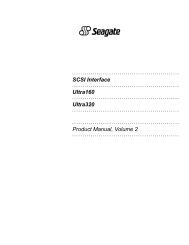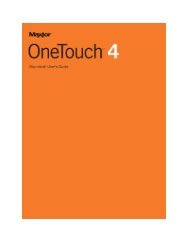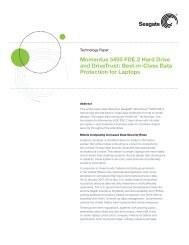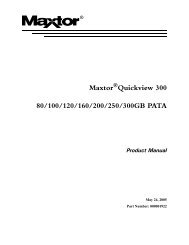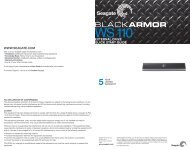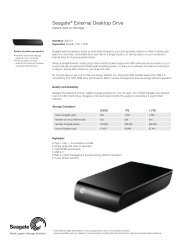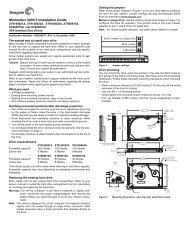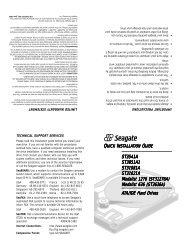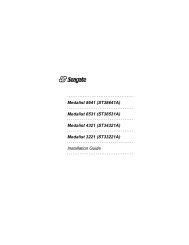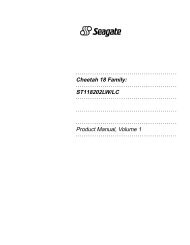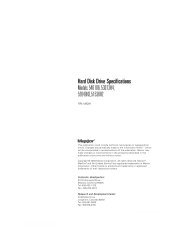Barracuda 18LP Family: ST39175LW/LC ST318275LW ... - Seagate
Barracuda 18LP Family: ST39175LW/LC ST318275LW ... - Seagate
Barracuda 18LP Family: ST39175LW/LC ST318275LW ... - Seagate
Create successful ePaper yourself
Turn your PDF publications into a flip-book with our unique Google optimized e-Paper software.
<strong>Barracuda</strong> <strong>18LP</strong> Product Manual, Rev. E 33<br />
8.0 Installation<br />
The first thing to do when installing a drive is to set the drive ID (select) on the SCSI bus and set up certain<br />
operating options. This is usually done by installing small shorting jumpers on the pins of connectors J2 and J6<br />
on the Printed Circuit Board Assembly (PCBA) (or J5 on the “LW” models), or via the drive to host I/O signals<br />
on “<strong>LC</strong>” models. Some users connect cables to J6 or J5 and perform the set-up using remote switches.<br />
If your system is “SCAM” (SCSI Configured Auto Magically) compliant, the system assigns the drive ID over the<br />
interface, so there is no need to be concerned about drive ID. Setting the drive ID jumpers doesn’t hurt anything,<br />
but is not necessary.<br />
If your system is not “SCAM” compliant you do need to set the drive ID using the ID jumpers.<br />
Configure drive options<br />
For option jumper locations and definitions refer to Figures 7a, 7b, and 7c. Drive default mode parameters are<br />
not normally needed for installation. Refer to Section 9.3.2 for default mode parameters if they are needed.<br />
• Ensure that the SCSI ID of the drive is not the same as the host adapter. Most host adapters use SCSI ID 7.<br />
ID 7 is the highest priority on both 8 and 16 bit data buses.<br />
• If multiple devices are on the bus set the drive SCSI ID to one that is not presently used by other devices on<br />
the bus.<br />
• If the drive is the only device on the bus, attach it to the end of the SCSI bus cable. On “<strong>LC</strong>” and “LW” models,<br />
external terminators must be provided by the user, systems integrator or host equipment manufacturer.<br />
• If the drive is attached to a bus that contains other devices, and if the new drive is not attached to the end of<br />
the bus, no terminators are needed.<br />
Note. For additional information about terminator requirements, refer to Sections 9.8 and 9.9.<br />
• Set all appropriate option jumpers for desired operation prior to power on. If jumpers are changed after<br />
power has been applied, recycle the drive power to make the new settings effective.<br />
• Installation instructions are provided by host system documentation or with any additionally purchased drive<br />
installation software. If necessary see Section 10 for <strong>Seagate</strong> support services telephone numbers.<br />
• Do not remove the manufacturer’s installed labels from the drive and do not cover with additional labels, as<br />
the manufacturer labels contain information required when servicing the product.<br />
Formatting<br />
• It is not necessary to low level format this drive. The drive is shipped from the factory low level formatted in<br />
512 byte sectors.<br />
• Reformat the drive if a different spare sector allocation scheme is selected.<br />
• High level format the drive involves assigning one or more partitions or logical drives to the drive volume.<br />
Follow the instructions in the system manuals for the system into which the drive is to be installed.<br />
• Systems that have Windows 95 Operating System version 950B (this has FAT 32) or later do not need to<br />
partition the drive in order to access the total capacity of the drive.<br />
8.1 Drive ID/option select header<br />
Figures 7a and 7b show views of the drive ID select jumper connectors. Figure 7c shows the option select<br />
jumper connector for all models. Figure 7b shows a rear view of model drives for the purpose of showing J5 of<br />
the drive. Both J5 and J6 have pins for selecting drive ID and for connecting the remote LED cable. Only one or<br />
the other should be used, although using both at the same time would not damage the drive. The notes following<br />
the figures describe the functions of the various jumper positions on the connectors J2, J5 and J6. See your<br />
local sales representative for suggested part number. A bag with the two jumper plug types is shipped with the<br />
standard OEM drives.



